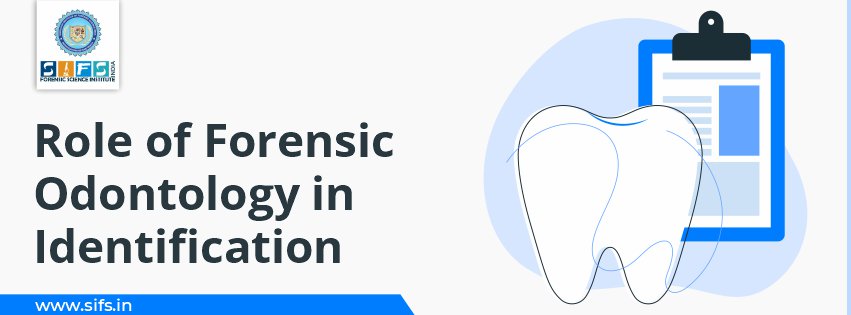- Call Us: +91 7303913002
- Email Us: education@sifs.in
Role of Forensic Odontology in Identification

BY SIFS India | February 10, 2020
Role of Forensic Odontology in Identification
Just like your fingerprints or snowflakes, there are no two teeth that are alike. Your teeth are unique and of one kind. Not even identical twins have the same teeth. Since teeth are specific to every individual they are often used as an identifier.
Significance of Teeth In Forensic
The external layer of teeth is composed of enamel which is the hardest tissue of body so it can hold out against trauma, decomposition, heat, degradation, water immersion, desiccation better than other body tissues.
Teeth are the most durable organ in the body and can be heated to a temperature of 1600 degrees Celsius without appreciable loss of microstructure and are usually the only remains after an extended period of burial.
Teeth are an outstanding source of DNA since they can stand up against conditions like humidity, temperature, and microbial action.
"What a nightmare! .... bodies as negroes, heads carbonized; shrunken and reduced to nothing, but only the teeth remained……" DR OSCAR AMEODO (FATHER OF FORENSIC ODONTOLOGY)
Forensic Odontology: Forensic derived from Latin word meaning ‘to the forum' and Odontology means the study of teeth.
KEISER NEILSON (1970) defined forensic odontology as a branch of dentistry that in the interest of justice deals with the proper handling and examination of dental evidence with proper evaluation and presentation of dental findings.
Purpose of Forensic Odontology
Forensic odontology plays a major role in both death investigations as well as in the evaluation of victims of sexual assault and child abuse.
The dental practitioner helps by keeping accurate dental records and providing all necessary information and identify individuals
Human dentition consists of incisor, canine, premolar, and molar that has a various dental feature like morphology, variations in shape and size, restoration, pathologies, missing tooth, wear pattern, crowding, color, position, rotation, dental anomalies which gives every individual unique identity.
Species Identification
Is the tooth found in the crime scene of human origin? Based on the morphology and anatomy of the tooth it can be identified whether it is of human or not. It is possible to determine even by dental tissue because dentinal fluid contains special information that can be compared and analyzed using counter current electrophoresis with artificial antisera.
Race Determination
Human species have been categorized into three races- Caucasoid , mongoloid , negroid. Dental characteristics such as shoveling, taurodontism, carebellies cusp hypocone, protostylid, peg shape incisor, etc are used to determine ancestry. Dental restoration also helps in finding the ethnicity of an individual. The type of dental treatment recommends the financial status of a person. Teeth provide important evidence regarding the habits and occupation of the individual.
Gender Determination
Sex determination plays a major part in the recognizable proof of unknown persons in a natural calamity, chemical, or nuclear bomb explosion. It can be done odontometric techniques which are measurements of the tooth. Dental indices are used to show sexual dimorphism. Gender can also be determined by the presence of sex chromatin or Barr bodies in the pulp.
Age Estimation
The requirement for age estimation has increased because of growth in number of unidentified cadavers and human remains and cases for living people with no substantial confirmation of date of birth. The number and sequence of teeth erupted in the jaw help in the determination of age. The radiographical method elaborates on various stages of mineralization and helps in giving an accurate estimation of age.
Bitemark Analysis
ABFO defines bitemarks as pattern left in an object or tissue by the dental structure of an animal or human. Bitemark inflicted by teeth are considered to be highly individualistic to a person and has been used since Roman times. Teeth are used as a weapon by an aggressor and as self-defense by the victim. Peculiar characteristics like missing teeth, malformed teeth, fractured teeth, crowding, diastema are helpful in the comparison process.
Comparative Dental Identification
Teeth play a critical role when the recognizable proof of remains of a perished individual is skeletonized, deteriorated, burned, or dismembered and cannot be distinguished by visual or unique strategies. The core of the forensic dental identification procedure is comparing the post mortem remains with antemortem records which include notes, radiographs, study cast, etc. In Disaster Victim Identification the dental evidence collected is compared to the antemortem records available to the dentist for identification of a deceased person.
DNA Analysis
Teeth are fabulous source of genomic DNA due to its resistant nature. In teeth, DNA is found in vascular pulp, odontoblastic process, accessory canal, and cellular cementum. Even the root-filled teeth provide sufficient material for PCR analysis which produces DNA profile which is further compared with antemortem samples or paternal DNA.
Conclusion
Your teeth are like your fingerprints. They are uniquely yours. That’s why forensic dentist use their expertise to help in the identification of remains found in the crime scene .
Forensic odontologists study and identify teeth, jaw, prosthesis, dental appliances, bitemarks, dental injuries, and dental records in the intrigued of justice.
References
Pretty I A, Sweet D (2001) A look at forensic dentistry-Part 1: The role of teeth in the determination of human identity
Divakar K P (2017) Forensic Odontology: The New Dimension in Dental Analysis
Krishan Kewal, Kanchan Tanuj and Garg Arun k (2015) Dental Evidence in Forensic identification- An Overview, Methodology and Present Status

